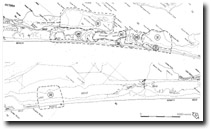GL31 Boole Boole Peninsula
|
This information has been developed from the publications:
|
| Location: | Easting 600 to Easting 700, Northing 940 to Northing 005. | |
Abstract: | Barrier formations, dunes and dune lakes; relict entrance channels; tidal delta islands. | |
Access: | Road to Sperm Whale Head and Rotomah Island. Boat access only to other areas. | |
Ownership: | Some Crown Land (The Lakes National Park and Gippsland Lakes Coastal Park), private land. | |
Geology: | All materials exposed here of Quaternary origin and include Pleistocene and Holocene barriers, dune rings, beach and lake shore sands, and swamp deposits. | |
Geomorphology: | The Boole Poole Peninsula is a complex feature and poses several problems in the interpretation of barrier history. On the northern side are low widely spaced ridges, similar in form and soil development to those identified as inner barrier Pleistocene ridges on Sperm Whale Head. However, the swales between the ridges are of lower elevation than those of Sperm Whale Head and it appears that this section of the inner barrier has subsided due either to tectonic activity or to compaction of underlying peat materials. By comparison, the ridges on the Bunga Arm side of Boole Poole Peninsula and at Jubilee Head are higher and more closely spaced and are of Holocene origin. They represent the first stages of beach ridge accumulation 700 to 600 years ago when the sea attained approximately its present level. Cliffed sections reveal beach and dune bedding structures in the sands of these ridges opposite Mullacky Lagoon. | |
Significance: | National. (Sites GL28, GL29, GL30, GL31 and GL32). The association of features here is of major importance in illustrating the evolution of the barrier systems of the Gippsland Lakes. Many details still remain to be worked out concerning the sequence of Pleistocene and Holocene depositional and erosional events and the sites described could be the subject of major studies in geomorphology supported by stratigraphy, palynology and radiometric dating. | |
Management: | The area requires maximum protection. Extensive grazing, trampling, construction works, roadworks, dredging or quarrying will lead to destruction of sensitive sand ridges and wetlands and could cause mobilization of dunes. | |



